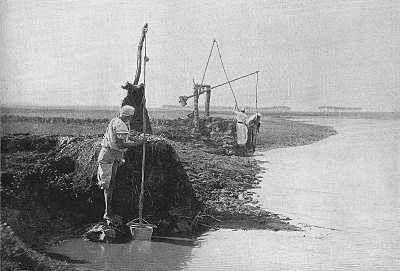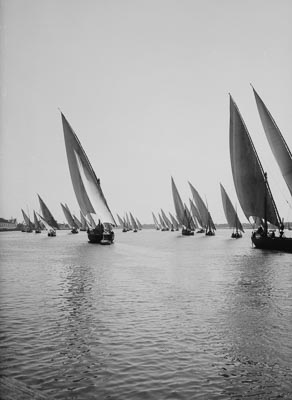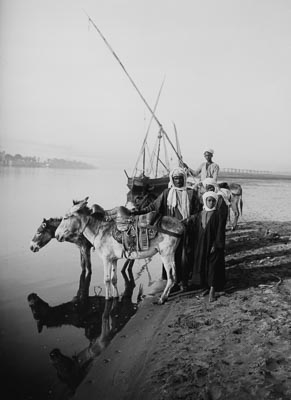
The Nile River

Source: Earthly Footsteps of the Man of Galilee, p. 41
The Drawer of Water from the Nile
We have here a glimpse of the River Nile, that long and wonderful river, which coming from what are even yet unknown sources, passes for more than fifteen hundred miles without a single tributary. The Nile means "the blue," "the dark." It is known in the Scriptures as "Sihor" and "the river of Egypt." Its banks are flat and monotonous. It is almost without islands. The valley of the Nile in the deserts immediately flanking it vary in the upper part from four to ten miles, and further south from fourteen to thirty miles. The soil deposited by the Nile averages thirty-three to thirty-eight feet deep in Egypt. "Throughout the whole of Egypt the Nile mud is said to rest on a bed of sea-sand." In the distance, in our picture, we see groves of palm trees, and over all stretches the blue and beautiful sky of Egypt. (Source: Earthly Footsteps of the Man of Galilee, p. 41.)
Fleet of Boats on the Nile

Source: American Colony: Egypt and Sinai
Nile scenery possesses a strange beauty of its own, but it is a monotonous unchanging beauty. Long lines of brown banks, a strip of vivid green behind them, narrow or wide according to the breadth of the valley and the facilities for irrigation, and beyond, closing in the view, a low rampart of yellow-brown hills-these are the only features of Egyptian scenery that meet the traveller's eye for mile after mile of his Nile voyage. Here and there a village, with its clump of palms, its shapeless mud huts and queer-looking pigeon towers, its sheykh's house and the little whitewashed dome which marks the tomb of a local celebrity, breaks the monotony; and at wider intervals a veritable town, with a few fairly-built houses and a couple of minarets, to show that, whatever it may appear, it is not merely a village like the rest, makes an agreeable diversion. But, as a rule, brown river, brown banks, and pale brown hills constitute the Egyptian triad in the unemotional tourist's recollection. (Source: Picturesque Palestine, vol. 4, pp. 189-90.)

Source: American Colony: Egypt and Sinai
Donkey Boys on the Banks of the Nile, Near Luxor
For the greater part of the way from Thebes to the First Cataract, and throughout Nubia, the hills hedge in the Nile so closely that there is scarcely room for any cultivation. Instead of the green plain one sees at Asyût or Abydos or Thebes, the upper valley of the Nile consists in a mere ribbon of vegetation, and often nothing beyond the sloping bank itself is cultivated. For miles a strip of green a yard wide and a fringe of palms behind form the sole relief to the brown mountain background . . . . Egypt, in fact, can hardly be said to exist in the upper course of the Nile. Instead of the frequent villages that met the eye every half-hour in the voyage below Thebes, a whole morning may be passed on the steamer's deck above Thebes without the sight of a human habitation. There is no land to cultivate and consequently no means of supporting a population . . . . A narrow streak of brown river, running between banks of rugged and precipitous hills, and encouraging only at very rare intervals the growth of sparse crops and the settlement of a sparse population-such is Egypt above Thebes. (Source: Picturesque Palestine, vol. 4, p. 216.)
See Flooding of the Nile River, Water in Egypt, Elephantine and Philae Islands, Karnak Temple, Thebes West Bank, Giza Pyramids and Sphinx, or Memphis
At BiblePlaces, see Nile River Valley